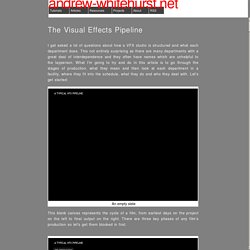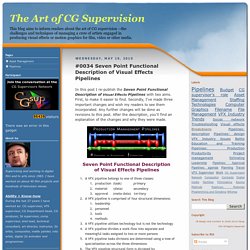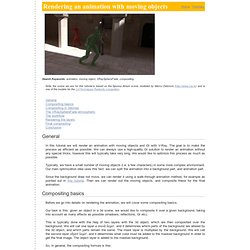

The Art of CG Supervision: Pipeline Articles. Andrew Whitehurst . Net. I get asked a lot of questions about how a VFX studio is structured and what each department does.

This not entirely surprising as there are many departments with a great deal of interdependence and they often have names which are unhelpful to the layperson. What I'm going to try and do in this article is to go through the stages of production, what they mean and then look at each department in a facility, where they fit into the schedule, what they do and who they deal with. Let's get started: An empty slate This blank canvas represents the cycle of a film, from earliest days on the project on the left to final output on the right. Pre-production Pre-production is the first stage of getting a film made and is characterised by all the work that is done before the shoot on set or location occurs.
Production Production is the actual shooting of the film. Post-production After the project has finished being filmed it enters post-production. Research and Development Tests Modelling Film scans. Adventures in Media » VFX Project Tools. Listed here, in no particular order, is my list of VFX project tools.

This is a list I started in 2008 while doing my own research for a VFX project management and tracking application. I update it from time to time, if you know of some VFX management software that is not listed here, please comment! If you are looking for my VFX Project Management and Collaboration tool, you can find it at ShotRunner.com. Last Updated: April 2013 File Management Simple systems for just managing collections of files on a hosted server. Dropbox I love Dropbox, it just works.
Digital Content Management systems These facilitate content management within a facility. Studio Management Tools Scheduling, budgeting, library management, calendaring, maintenance schedules, equipment check-out, etc., all functions needed to run a studio. Studio Suite X Studio management software suite.Farmer’s Wife Funny name. Shotgun is the leading system installed at several big studios. Review and Annotation Tools. The Art of CG Supervision: #0034 Seven Point Functional Description of Visual Effects Pipelines.
In this post I re-publish the Seven Point Functional Description of Visual Effects Pipelines with two aims.

First, to make it easier to find. Secondly, I've made three important changes and wish my readers to see them incorporated. Any further changes will be done as revisions to this post. After the description, you'll find an explanation of the changes and why they were made. Seven Point Functional Description of Visual Effects Pipelines First change: Leadership. I've decided the leadership structure is far too important and must be separate from personnel.The tasks and training are significantly different enough that it must be looked at as a separate dimension. Too often leaders are merely promoted from the best artists and left on their own to figure out how to lead. Second change: Methods.
Third change: Visual Effects Pipelines. Enough with words --onward to production pipeline design... Rendering an animation with moving objects. Search Keywords: animation, moving object, VRaySphereFade, compositing Note: the scene we use for this tutorial is based on the Sponza Atrium scene, modeled by Marco Dabrovic ( and is one of the models for the CGTechniques Radiosity competition.

General Compositing basics Compositing in 3dsmax The VRaySphereFade atmospheric The workflow Rendering the layers Final compositing Conclusion General In this tutorial we will render an animation with moving objects and GI with V-Ray. The goal is to make the process as efficient as possible. Compositing basics Before we go into details on rendering the animation, we will cover some compositing basics.
Final_image = background_layer * mask_layer + object_layer Our background layer is given, and we don't have to worry about it. Given these three renders, we can compute the mask layer and the object layer in this way: mask_layer = black / pure; object_layer = normal - black; Then, we can use the mask and object layers to composite the final image. Workflow.